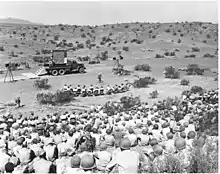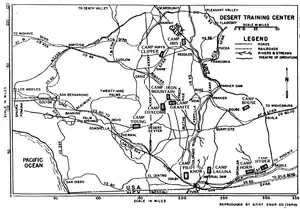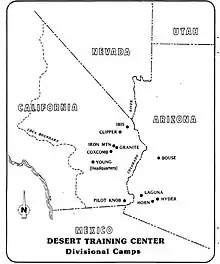Camp Clipper
The Camp Clipper and Camp Essex were sub camps of the US Army Desert Training Center in Riverside County, California. The main headquarters for the Desert Training Center was Camp Young, this is where General Patton's 3rd Armored Division was stationed. Camp Clipper was designated a California Historic Landmark (No.985.5). The site of the Camp Essex at the Fenner Rest Area in Fenner, California, on Interstate 40, 32 miles (51 km) west of Needles in San Bernardino County, California, near Clipper Mountains. Currently at the south end of the Mojave National Preserve. Camp Clipper was just to the east of Camp Essex, it was a temporary camp for incoming and out going troops. Camp Essex was named after a small town near the camp, Essex, San Bernardino County, California. Near the camp was the 4,500 foot Camp Essex Army Airfield.[1][2]
| Camp Clipper and Camp Essex | |
|---|---|
 Camp Clipper in June 1943, 108th ECB street | |
| Location | near Fenner, California |
| Coordinates | 34°48′30″N 115°13′10″W |
| Area | 21,537.78 acres |
| Built | 1942 |
| Architect | US Army |
| Reference no. | 985.5 |
 Location of Camp Clipper and Camp Essex in California | |





Built in 1942, Camp Essex and Camp Clipper were built to prepare troops to do battle in North Africa to fight the Nazis during World War II. At Camp Clipper were trained the 93rd Infantry Division. The trained troops went on to fight in the North African campaign. There was a temporary camp built for the training of the 33rd Infantry Division. When completed the camp had 36 shower buildings, outdoor theater, 191 latrines, 149 wooden tent frames, and a 50,000-gallon water tank. Also built was a 500,000 gallon concrete reservoir and two 740-foot-deep wells. Camp had 14 training ranges. The camp was used shortly in 1944 for Italian prisoners of war. The camp closed on 16 March 1944 and is now overseen by the Bureau of Land Management. The army used live-fire exercises and warning signs are still on the site.[3][4][5]
Operating Camp Essex:
- 356th Engineer General Service Regiment (AGF)
- Company A
- Company E
- Trained at the camp: 93rd Infantry Division from July of 193 to October 1943
Operating Camp Clipper:
- 16th Special Service Company (AGF)
- 2nd Service Platoon
- 605th Engineer Camouflage Battalion (AGF)
- Company C
- Trained at the camp: 33rd infantry Division from April 1943 to July 1943
Camp Essex Army Airfield
There was an air strip near the camp to support training activities. The runway was a two 4,500 feet long runs made of steel landing mats with 6 parking pads at each end of the runway. The runway was a position north-south, parallel to the old U.S. Route 66 and Camp Clipper. The runway was from use for small planes, like the L-4 Piper Aircraft so the vast training grounds could be watched from the air. The runway was long enough for the large planes to used in training exercises like the: Douglas C-50 cargo plane, Douglas A-20 Havoc, Curtiss P-40 Warhawk, Lockheed P-38 Lightning and Consolidated B-24 Liberator. In early 1950 the airfield was used as a private airfield, being not maintain it was abandoned in the late 1950s.[8]
Marker
Marker at the Eastbound Rest Stop in California reads:[9]
- NO. 985 DESERT TRAINING CENTER, CALIFORNIA-ARIZONA MANEUVER AREA (ESTABLISHED BY MAJOR GENERAL GEORGE S. PATTON, JR.) - CAMP CLIPPER - Camp Clipper was established at a site that reached from Essex Road to this location in the Spring of 1942. It was one of twelve such camps built in the southwestern deserts to harden and train United States troops for service on the battlefields of World War II. The Desert Training Center was a simulated theater of operations that included portions of California, Arizona, and Nevada. The other camps were Young, Coxcomb, Iron Mountain, Ibis, Granite, Pilot Knob, Laguna, Horn, Ryder, Bouse and Rice. A total of 13 infantry divisions and 7 armored divisions plus numerous smaller units were trained in this harsh environment. The Training Center was in operation for almost two years and was closed early in 1944 when the last units were shipped overseas. During the brief period of operation over one million American soldiers were trained for combat. The 33rd and 93rd Infantry Divisions were trained here.
See also
External links
References
- California Parks Historic Landmark, San Bernardino County
- Camp Essex Army Airfield photo in 1953
- Sky Trail Camp Clipper
- The Desert Training Center, “The Place that God Forgot”
- skytrail Camp Essex
- militarymuseum.org Camp Clipper
- deserttrainingcenter.com Desert Training Center history
- airfieldsfreeman.com, Camp Essex Army Airfield
- californiahistoricallandmarks.com 985.5, Camp Clipper
